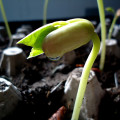
The tale of Jack and the Beanstalk has always been one of my favorites. This year, we grew beans at preschool, and they certainly tried to reach for the sky. Of course, the roof was in the way, but I’m sure that they would have gotten up to the clouds if it weren’t for that pesky roof.
I’ve grown beans since I was a child. They are easy to grow, and some varieties are satisfyingly tall. Beans picked straight from the garden are sweet and delicious. Although I am not a real fan of vegetables that are frozen, baked, or boiled, I do love raw beans.
Like peas, beans contain nitrogen-fixing bacteria. While this fertilizer can be a bit much for some plants, it is very good for corn, carrots, beets, and strawberries. If you’re looking for other good companions for your beans, plant them next to summer savory and eggplant to encourage your beans to grow more vigorously.
Growing Your Beans
Beans are fairly simple to grow. They do like to be warm, but they don’t need a large amount of heat. If you have a completely shady garden, beans are likely out. However, if you can’t grow tomatoes, don’t despair – try beans, and they may survive and thrive. If you have a very cool yard, try growing your beans close to the house – the heat of the walls may give them the extra boost that they need.
Supporting Your Beans
Bush beans are compact bushes that require little if any trellising. However, the giants of the bean world require space. This year, I have a net over my garden to keep the cats out, and my beans have invaded the net. They’ve climbed all of the way up the next, on top of the fence, and they are climbing the apple tree. Needless to say, these beans like support. They are vines. A tomato cage won’t cut it – beans really require super structures! I love the trellises in Square Foot Gardening, and I’m going to try them out next year. They consist of pipes arranges into a large “u” shape, with strings running up to the top of the frame. Currently my beans make their way over a large lattice. I trained them up through the cracks in the lattice to the top, and then I wove them in and out of the lattice.
Harvesting Your Beans
One of the most frequent questions of backyard bean farmers? When are my beans ready to eat? For me, beans are ready to eat when they are tender and about the size of my palm. When beans get really long, they are amazing to look at, but they are often woody in texture and unpleasant to eat. When they get bumpy, it’s all over and you are better off saving them for seed.
Saving Seeds from Your Beans
To save bean seeds for next year, simply let the beans mature. Do this with your healthiest plants – you don’t want to save seeds from wimpy plants! Wait until the pods are dry and the seeds are rattling inside them. Set the beans out for a day or two to make sure they are actually dry, then label them and store them in the fridge for next year. Make sure that you only choose the large, smooth beans.
Enjoy your garden this summer – and enjoy growing your beans! May many an archway covered in beans live in your children’s memories of summer.








